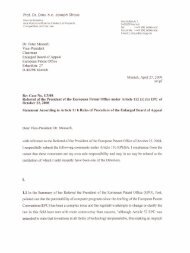Assessing the Obstacles to Industrialisation: The ... - Innovation
Assessing the Obstacles to Industrialisation: The ... - Innovation
Assessing the Obstacles to Industrialisation: The ... - Innovation
You also want an ePaper? Increase the reach of your titles
YUMPU automatically turns print PDFs into web optimized ePapers that Google loves.
zoStephen H. Haberenter <strong>the</strong> international market, but was a resounding failure. <strong>The</strong> lack ofa merchant marine <strong>to</strong> ship its goods <strong>to</strong> foreign markets, <strong>the</strong> lack ofinstitutions <strong>to</strong> provide credit <strong>to</strong> exporters, <strong>the</strong> competition of producersfrom <strong>the</strong> advanced industrial economies, and high tariff barriers in o<strong>the</strong>rLatin American countries, all worked against Mexican industrial exports."A second obstacle <strong>to</strong> successful industrialisation was <strong>the</strong> lowproductivity of hlexican labour compared with that in <strong>the</strong> advancedindustrial countries, and this again pushed up production costs. <strong>The</strong>Mexican working class had its social roots in <strong>the</strong> peasantry; many workerswere only recently off <strong>the</strong> farm; some moved back and forth between <strong>the</strong>fac<strong>to</strong>ry and <strong>the</strong> field. <strong>The</strong>y <strong>the</strong>refore worked with <strong>the</strong> rhythm of apeasantry, not of an industrial proletariat. For this reason Mexicanindustrialists did not have <strong>the</strong> same degree of control over labour as did<strong>the</strong>ir counterparts in <strong>the</strong> United States, England or Germany. Though<strong>the</strong>y could force workers <strong>to</strong> work long hours, <strong>the</strong>y could not instil in<strong>the</strong>m <strong>the</strong> attitudes and values that are essential <strong>to</strong> <strong>the</strong> development ofindustrial discipline. Like European industrialists in <strong>the</strong> late eighteenthand early nineteenth centuries, Mexican fac<strong>to</strong>ry owners regularlycomplained about <strong>the</strong> 'laziness' of <strong>the</strong>ir work force and <strong>the</strong>ir inability <strong>to</strong>force <strong>the</strong> workers <strong>to</strong> submit <strong>to</strong> routinised work.'*This resistance on <strong>the</strong> part of <strong>the</strong> working class <strong>to</strong>ok two forms. One wasthat workers openly resisted employers' attempts <strong>to</strong> increase productivityor achieve greater discipline on <strong>the</strong> shop floor. <strong>The</strong>re were even occasionswhen entire shifts of workers abandoned <strong>the</strong>ir machines in order <strong>to</strong> attenda fiesta at a nearby hacienda or Darrio.j3 <strong>The</strong> second was that hlexicanworkers generally worked less intensively than did <strong>the</strong>ir American orEuropean counterparts. In <strong>the</strong> weaving departments of Mexico's cot<strong>to</strong>ntextile mills in 1910, for example, <strong>the</strong> average worker operated 2.j looms,j1 For a detailed discussion of this attempt <strong>to</strong> export manufactured goods during <strong>the</strong>Porfiria<strong>to</strong> see Haber, Industry and LTnderde~melopment, pp. 39-43j2 For a typical analysis of <strong>the</strong> productivity of Alesican labour by a Mexican industrialistsee Jose Robredo, Pun<strong>to</strong> de t'ista de los indusfriales de bilados-y fejidos de la Repciblica (Alexico,I 9t r), p. > I. For a similar analysis by a foreign observer see G. Jenner, ' Informe de hfrG. Jenner sobre la inversion del capital ingles en hiexico', in Informesj documen<strong>to</strong>sreiaticos a comercio interior, mes de setiembre 1886 (hiexico, I 886). This experience with <strong>the</strong>slow transition <strong>to</strong> 'fac<strong>to</strong>ry time' u7as not unique <strong>to</strong> Llexico. In hfeiji Japan, forexample, people returning from stud! or work abroad regularly commented on <strong>the</strong>laxness and lack of time discipline of Japanese workers compared <strong>to</strong> <strong>the</strong>ir Westerncounterparts. <strong>The</strong> transition <strong>to</strong> modern conceptions of time and work, hourever,appears <strong>to</strong> have proceeded more rapidly in Japan than in Mexico. See Thomas C.Smith, Satiz'e Sources oj',/apanese Industrialipation, I;JO-1920 (Berkeley, I 98 8), p p z t >-8.j3One of <strong>the</strong> more no<strong>to</strong>rious cases of this occurred in <strong>the</strong> San Lorenzo cot<strong>to</strong>n mill inOrizaba \'eracruz in igrj. For details on this case see Archivo General de la Sacion,Ramo de Trabajo, Box > 60, file 6, doc. I I.





